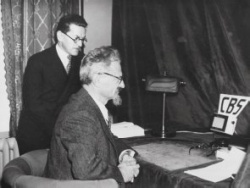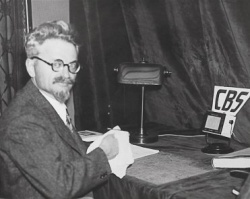Trotskij was here! - Stories from Købmagergade II
20. Nov. 2008

Trotsky in front of CBS's microphone in the studio of the State Telephone in Købmagergade.
A Media Event
It did not pass off quietly when the news about Trotsky's visit reached the press. The Social Democratic Students Association had invited him to hold a lecture on the occasion of the 15th anniversary of the Russian Revolution and the Social Democratic government had issued an eight-day visa to Trotsky and exacted a promise from him of a scientific lecture with no comments to current politics.
Trotsky had been removed from power by Stalin already in 1928 and was now in exile in Turkey, but to his western contemporaries Trotsky was "the greatest living figure of the Russian Revolution", „the creator of the Red Army", Stalin's most famous opponent/victim - and an ardent spokesman for a world-encompassing socialist revolution. For the first time since his banishment he was going to appear in public in Western Europe. To receive him was to invite trouble internally among socialist groupings and externally vis-à-vis the Soviet Union.
Focus on Security
Surrounded by security agents and with the press in close pursuit, Trotsky left for Copenhagen with his wife and child. The journey took ten days by ship from Istanbul via Naples to Marseilles, by police-escorted car through France to Dunkirk from where another ship brought the family to Esbjerg on 23rd November. Here the Danish State Railways and Danish security agents took over - dodging the waiting crowd at the Copenhagen Central Station by having Trotsky leave the train in Taastrup. In Copenhagen the family was accommo-dated privately on varying secret addresses. An abundance of newspaper articles and interviews covered his stay.

Lev Trotsky (formerly Bronstein, born in Russia 1879) ready to speak to the American listeners.
The Lecture
In the evening of Sunday the 27th November Trotsky talked about the Russian Revolution in front of an audience of 2,500 people in a sports centre in Copenhagen. His own security corps, which included a group of German Trotskyists who had been cycling from Hamburg to Copenhagen in order to pro-tect their leader, had lined up between him and the audi-ence. Trotsky spoke in German, and Hartvig Frisch summed up in Danish. Outside, Danish Stalinist Communists were demonstrating, but everything passed off peacefully. According to the press the lecture was rather boring. It is said to have been recorded by Fox Film whereas the state broadcasting service had rejected to transmit Trotsky's lecture to the US without reason.
In the Archives
This is where the two photos from the museum archives come in: Trotsky in front of a CBS microphone in a curtained studio at the Central Telegraph Station in Købmagergade. A photographer immortalized the renowned visit, and the staff at the Danish Post and Telegraph Museum filed the pictures with the note: „Trotsky speaks from the studio in the State Telephone Office in Købmagergade via Berlin-Brussels-London to the listeners in USA on Sunday the 27th November 1932."
CBS is an abbreviation of Colombia Broadcasting System which began transmissions in 1927. So Trotsky actually spoke to the American listeners during his visit in Copenhagen; not in German in a radio transmission from a public theatre, but in English online via the telephone network observing the highest possible level of security of that time behind the closed doors of the Central Telegraph Station.
On the Internet
The reaction in the US can be "googled" today. Both the New York Times (of 28th November 1932) and Time Magazine (of 5th December 1932) are mentioning Trotsky's radio speech. It appears that the recording took place on the same day as the lecture in the sports centre, and allegedly the famous revolutionary received a fee of $1,000 whilst he got $5,000 for speaking in front of the „U.S. sound newsreel cameras" which supplied sound films for the newsreels in the American cinemas. It is perhaps this recording that is behind the mention of Trotsky's „first talking pictures interview" in Copenhagen, incorrectly dated to the 1920's in Archive Films' catalogue.
Damage Control
The Danish State had provided safe settings for Trotsky and the foreign media, and one might be tempted to assume that the government would hardly unwelcome it rumours of rejection of a radio transmission were in circulation. The situation had been dexterously managed; now it was a matter of getting rid of the problematic guest, who did everything he could to delay his departure. The authorities were determined, put the family into a car and drove them to the ship in Esbjerg at the expiry of the residence permit. Trotsky later settled in France and Norway - and finally in Mexico where he was killed by a Soviet agent in 1940.
This article may be copied or quoted with MuseumsPosten, Post & Tele Museum as source.
Comment this article
Only serious and factual comments will be published.